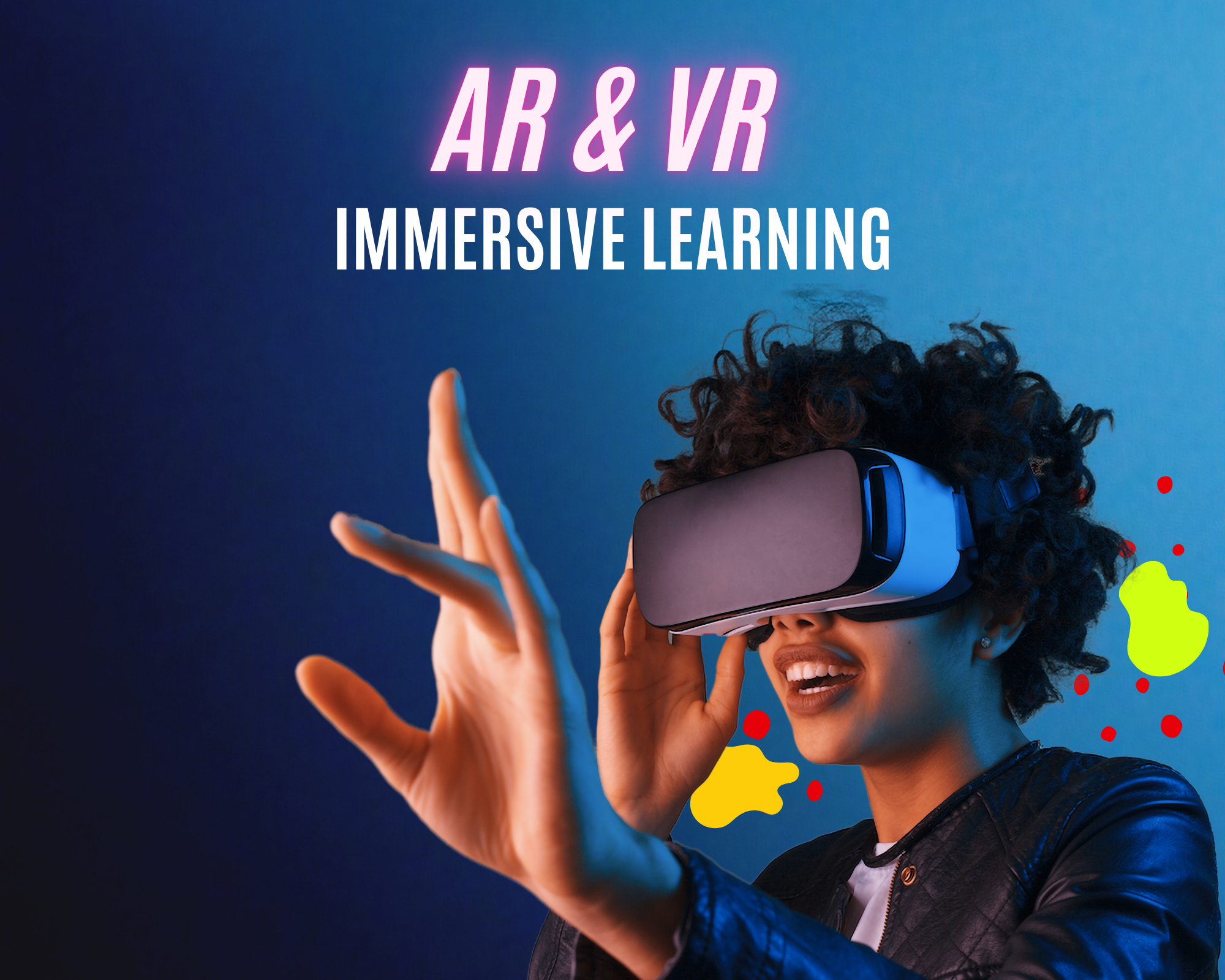As we enter 2025, education is changing a lot. Immersive learning is leading this change with new tech and this is something we definitely watch out for.
Get ready to see how Virtual Reality (VR) and Augmented Reality (AR) are changing learning. These new tools are making school more fun and hands-on. They’re making learning better and more fun.

Key Takeaways
- Immersive learning technologies are transforming education.
- VR and AR are key drivers of this transformation.
- These technologies make learning more engaging and interactive.
- The educational experience is becoming more effective and enjoyable.
- Innovations in immersive learning are expected to continue in 2025.
The Evolution of Immersive Learning in 2025
Immersive learning is on the verge of a big change in 2025. This is thanks to new VR and AR tech. These tools are making learning better and opening up new ways to share educational content.

Key Technologies Transforming Education
Virtual Reality (VR) and Augmented Reality (AR) are changing education. They offer interactive and fun ways to learn. This makes hard topics easier to understand.
A recent report says, “The future of education is in immersive tech. It makes learning more fun and effective.”
“Immersive learning technologies have the potential to revolutionize the education sector by providing personalized and interactive learning experiences.”
Market Projections and Growth Trajectories
The immersive learning market is set to grow a lot in 2025. There will be more demand for VR and AR in schools and universities.
Investment Trends in Educational Technology
Edtech investment is going up, especially in immersive learning. Venture capitalists are backing startups with new VR and AR educational products. This shows they believe in immersive learning’s power to change education.
VR & AR Technologies Reshaping Educational Experiences
As we enter 2025, VR and AR are changing education. You’re about to see a big change in how we learn.
Beyond Traditional Classroom Boundaries
VR and AR are breaking free from old classroom rules. With VR in education, you can explore places like historical sites and distant planets. You can even dive into the human body in a fun and interactive way.

Experiential Learning Through Digital Immersion
Experiential learning gets a boost from digital immersion. You don’t just learn theory; you apply it in a simulated world. This is great for fields like medicine, where AR in education helps you see complex structures.
Cognitive Benefits of Immersive Learning
The cognitive benefits of immersive learning are many. Studies show it improves memory and understanding.
Memory Retention and Knowledge Transfer
Research shows immersive learning boosts memory and knowledge sharing. You’re more likely to remember when learning is fun and interactive.
| Learning Method | Retention Rate | Knowledge Transfer |
|---|---|---|
| Traditional Learning | 20% | Limited |
| Immersive Learning | 80% | Effective |
Breakthrough Hardware Developments for 2025
Immersive learning is on the verge of a big change thanks to new hardware. By 2025, several important updates will make learning more immersive.
Ultra-Lightweight Headsets and Eyewear
New VR hardware and AR hardware are getting better. Now, headsets and eyewear are lighter and more powerful. This means learners can enjoy immersive experiences for longer without getting tired.
All-Day Battery Solutions
Battery life was a big problem with immersive learning tech. But, all-day battery solutions are now available. This means learning can go on without interruptions from needing to recharge.
Advanced Haptic Systems for Tactile Learning
Advanced haptic systems are being added to learning platforms. They let learners feel things, making learning more real and effective.
Neural Feedback Integration
Another exciting update is neural feedback in learning hardware. This tech watches how a learner’s brain responds in real-time. It helps make learning more personal and effective.
These hardware breakthroughs will change immersive learning. They will make it more accessible, effective, and fun for learners everywhere.
AI-Enhanced Immersive Learning Platforms
AI is changing how we learn, making it more personal and effective. It combines with immersive tech to offer learning paths that fit each learner’s needs.
Adaptive Content Generation
AI lets us create learning content that changes as you go. It adjusts to your level, keeping you challenged but not too hard.
Intelligent Virtual Instructors
AI-powered virtual teachers give you one-on-one help. They offer feedback right away, helping you grasp tough ideas better.
Personalized Learning Algorithms
At the core of AI learning platforms are algorithms that tailor your learning. They look at how you learn, what you like, and how well you do to make your learning plan.
Emotional Intelligence in Virtual Learning Environments
AI can now sense and react to how you feel in virtual classes. This makes learning a more caring and supportive place.
| Feature | Description | Benefit |
|---|---|---|
| Adaptive Content | Real-time adjustment of learning material | Personalized learning experience |
| Virtual Instructors | AI-powered guidance and feedback | Improved understanding and retention |
| Emotional Intelligence | Detection and response to learner emotions | Supportive learning environment |
Spatial Computing in Educational Settings
Spatial computing is changing how we learn. It brings persistent digital learning spaces and places where many can work together. This tech makes learning more real and exciting, beyond just classrooms.
Persistent Digital Learning Spaces
These virtual places stay open for students to keep learning. Persistent digital learning spaces help with long projects. Students can easily pick up where they left off, making learning smoother.
Collaborative Multi-User Environments
Spatial computing makes collaborative learning easier. It lets many students work together in one virtual space. This helps students learn to work as a team, communicate better, and solve problems together.
Digital Twin Technologies for Education
Digital twin tech in education lets students explore real-world places safely. It creates virtual copies of real environments. This way, students can learn about complex systems in a safe space, helping them understand better.
K-12 Immersive Learning Applications for 2025
Exploring the future of K-12 education reveals the power of immersive learning in 2025. Immersive learning is changing K-12 education. It offers VR/AR experiences that fit the needs of young learners.
Developmentally Appropriate VR/AR Experiences
Educators can now give students VR/AR experiences that are both fun and educational. These experiences are made to be developmentally appropriate. They meet the needs of students at different ages.
Virtual Science Laboratories and Field Trips
Immersive learning brings virtual science laboratories and field trips to K-12 education. These virtual experiences let students do experiments and learn about complex science concepts safely.
| Feature | Traditional Learning | Immersive Learning |
|---|---|---|
| Lab Experiments | Limited by resources and safety concerns | Unlimited possibilities with virtual labs |
| Field Trips | Limited by location and cost | Accessible from anywhere with VR/AR |
Historical Reenactments and Cultural Experiences
Immersive learning makes historical reenactments and cultural experiences come alive. Students can explore ancient civilizations and witness key historical events. They can also engage with different cultures in a more immersive way.
Gamified Learning Objectives
To make learning more engaging, educators use gamified learning objectives. This approach makes learning interactive and fun. It boosts student motivation and participation.
Advanced Simulations for Higher Education and Workforce Training
In 2025, advanced simulations are changing higher education and workforce training. This change is making learning and skill development better for students and professionals.
Medical Procedure Rehearsal and Anatomical Study
Medical education is getting a boost from advanced simulations. They create realistic settings for practicing surgeries and studying anatomy. Medical simulation lets students hone their skills safely, boosting their confidence.
Engineering and Architectural Visualization Tools
Simulations are also changing engineering and architecture education. They let students see complex structures and systems in 3D. This helps them understand complex ideas better through interactive models.
Corporate Training and Leadership Development
In the corporate world, simulations are used for training and leadership development. They give employees a safe space to practice making decisions and solving problems. Corporate training is now more effective and fun.
Crisis Management and Decision-Making Scenarios
Simulations are key in corporate training for crisis management and decision-making. Employees face real crisis situations, learning to respond well under pressure.
Advanced simulations are making education and professional development more immersive and effective. We’re entering a new era in learning and development.
Inclusive Design in 2025’s Immersive Learning Tools
In 2025, we’re seeing a big change in how immersive learning tools are made. These tools are getting better at reaching everyone, no matter their abilities or where they come from. This is because we now know how important it is for all learners to have access.
Accessibility Features for Diverse Learning Needs
Immersive learning tools are now packed with features to help different learners. You can change font sizes and colors to fit your needs. There are also audio descriptions for visually impaired learners and subtitles for those who are deaf or hard of hearing. These features make learning more inclusive for everyone.
Cultural Adaptation and Localization
It’s important to make immersive learning tools fit for everyone around the world. Developers are working hard to make sure the content is culturally sensitive and relevant for different places. They’re not just changing the language but also making sure the learning material fits the local culture.
Bridging the Digital Divide
One big challenge is making sure everyone can use these tools. We’re working to improve internet accessibility and develop affordable hardware solutions. This way, learners from all walks of life can enjoy immersive learning technologies.
| Feature | Description | Benefit |
|---|---|---|
| Customizable UI | Allows learners to personalize font sizes and color schemes | Enhances readability and comfort |
| Audio Descriptions | Provides verbal descriptions of visual content | Aids visually impaired learners |
| Subtitles | Displays text for audio content | Assists learners who are deaf or hard of hearing |
Learning Analytics and Assessment in Virtual Environments
Exploring immersive learning shows how learning analytics and assessment in virtual environments are changing education. This change lets teachers see how students learn and perform in new ways.
Continuous Performance Monitoring
Continuous performance monitoring tracks student progress in real-time. It uses advanced algorithms to analyze data from virtual environment interactions.
Physiological Response Tracking
Physiological response tracking is a new method in immersive learning analytics. It tracks how students feel and engage, helping teachers understand their emotional states.
Competency-Based Evaluation Models
Competency-based evaluation models are being used to better measure student skills. These models focus on specific skills and knowledge, not just grades.
Privacy-Preserving Data Collection
As learning analytics grow, keeping student data private is key. Strong data protection measures are needed to protect learner information.
| Analytics Method | Description | Benefits |
|---|---|---|
| Continuous Performance Monitoring | Real-time tracking of student progress | Early identification of areas needing improvement |
| Physiological Response Tracking | Monitoring learner physiological responses | Better understanding of learner engagement |
| Competency-Based Evaluation | Assessment based on specific skills and knowledge | More accurate evaluation of learner proficiency |
Overcoming Implementation Barriers in 2025
Immersive learning is becoming more popular, but schools face many challenges. They need to find ways to overcome financial, infrastructural, and training hurdles.
Sustainable Funding and Cost Reduction Strategies
Finding steady funding is a big challenge. Schools can look for grants, team up with tech companies, and start small. This way, they can make immersive learning more affordable.
Infrastructure Requirements and Solutions
Good infrastructure is key for VR and AR. Schools need fast internet, the right hardware, and safe data storage. Using cloud services can help save money and grow easily.
Educator Professional Development Programs
Teachers need to know how to use these new tools. Schools should offer training and support. This helps teachers feel confident and share their knowledge.
| Barrier | Solution | Benefit |
|---|---|---|
| Sustainable Funding | Diversify funding sources, seek grants, and partner with tech companies | Financial viability and reduced costs |
| Infrastructure Requirements | Invest in cloud-based solutions and high-speed internet | Scalability and reduced infrastructure costs |
| Educator Training | Professional development programs with hands-on training and ongoing support | Increased educator confidence and effective integration of immersive learning tools |
Global Standards and Emerging Best Practices
Immersive learning technologies are growing fast. Global standards and best practices are key to this growth. It’s important to know the frameworks supporting immersive learning’s future.
Content Development Frameworks and Tools
Content frameworks are crucial for quality immersive learning. They make sure content is pedagogically sound and meets different learners’ needs. Expect to see better tools for creators soon.
Safety Protocols and Digital Wellbeing
Safety protocols and digital wellbeing are now top priorities. Developers are adding features to protect users from immersive tech risks. This ensures a safe learning space for everyone.
Interoperability Between Learning Platforms
Interoperability is essential for smooth immersive learning across platforms. Work is underway to create common standards. This will make it easier to share and use learning content.
Regional Regulatory Considerations
Remember, regional regulatory requirements are important for immersive learning. Knowing these rules helps avoid legal problems and ensures compliance.
Conclusion: Preparing for the Immersive Learning Revolution
Looking ahead to 2025, the immersive learning revolution is set to change education. You’ve seen how VR, AR, AI, and spatial computing are leading this change. These technologies are making learning more fun, easy, and effective.
Immersive tech is making education more engaging and accessible. By using VR/AR, you can get ready for a learning experience that’s both interactive and tailored to everyone’s needs.
To make the most of this revolution, keep up with new tech and teaching methods. As education keeps evolving, you’ll be ready to adapt and take advantage of new chances.
FAQ
What are the key technologies driving immersive learning in 2025?
Virtual Reality (VR) and Augmented Reality (AR) are leading the way in immersive learning. They make learning more engaging and open up new ways to share educational content.
How is AI being used in immersive learning platforms?
AI helps make learning personal and adaptive in immersive platforms. It generates content on the fly, offers smart virtual instructors, and uses algorithms to tailor learning to each student.




